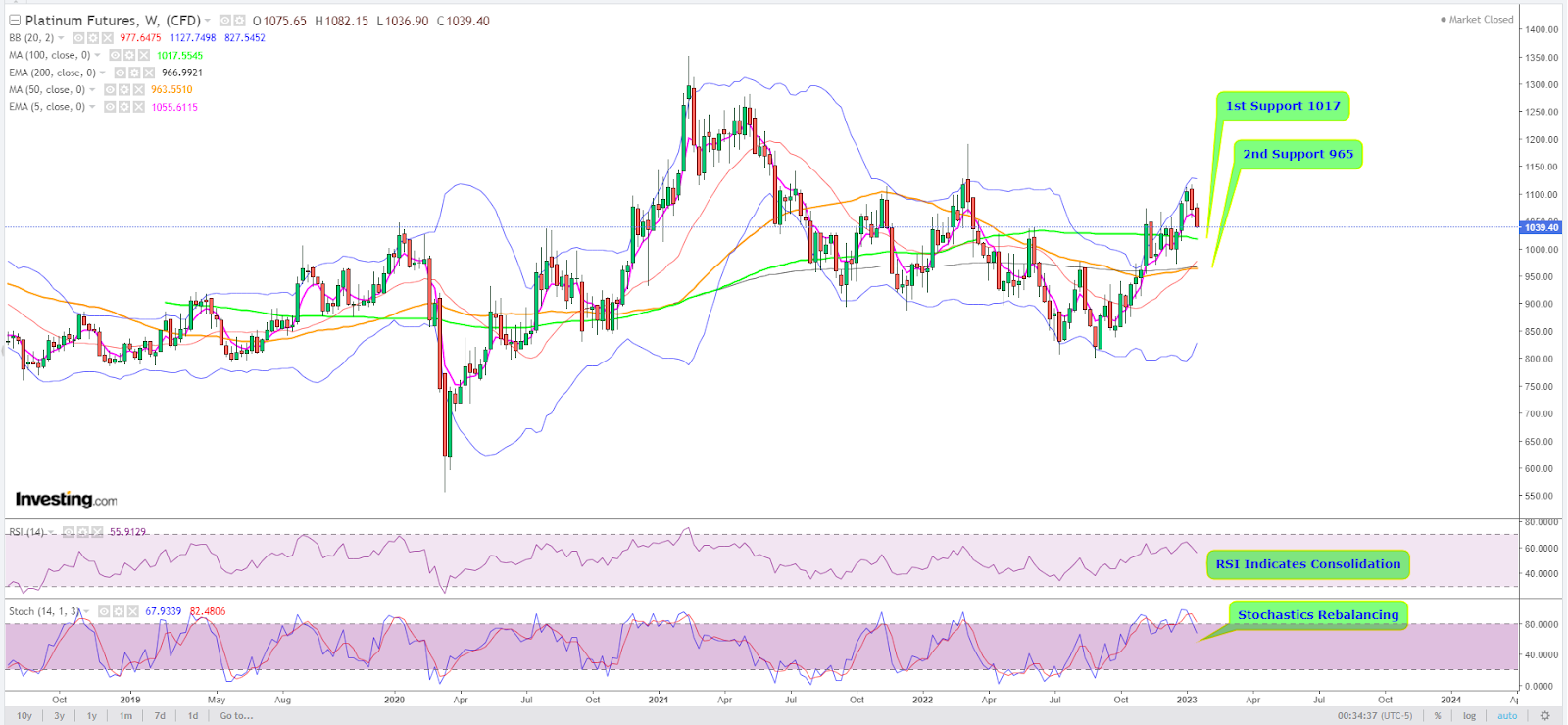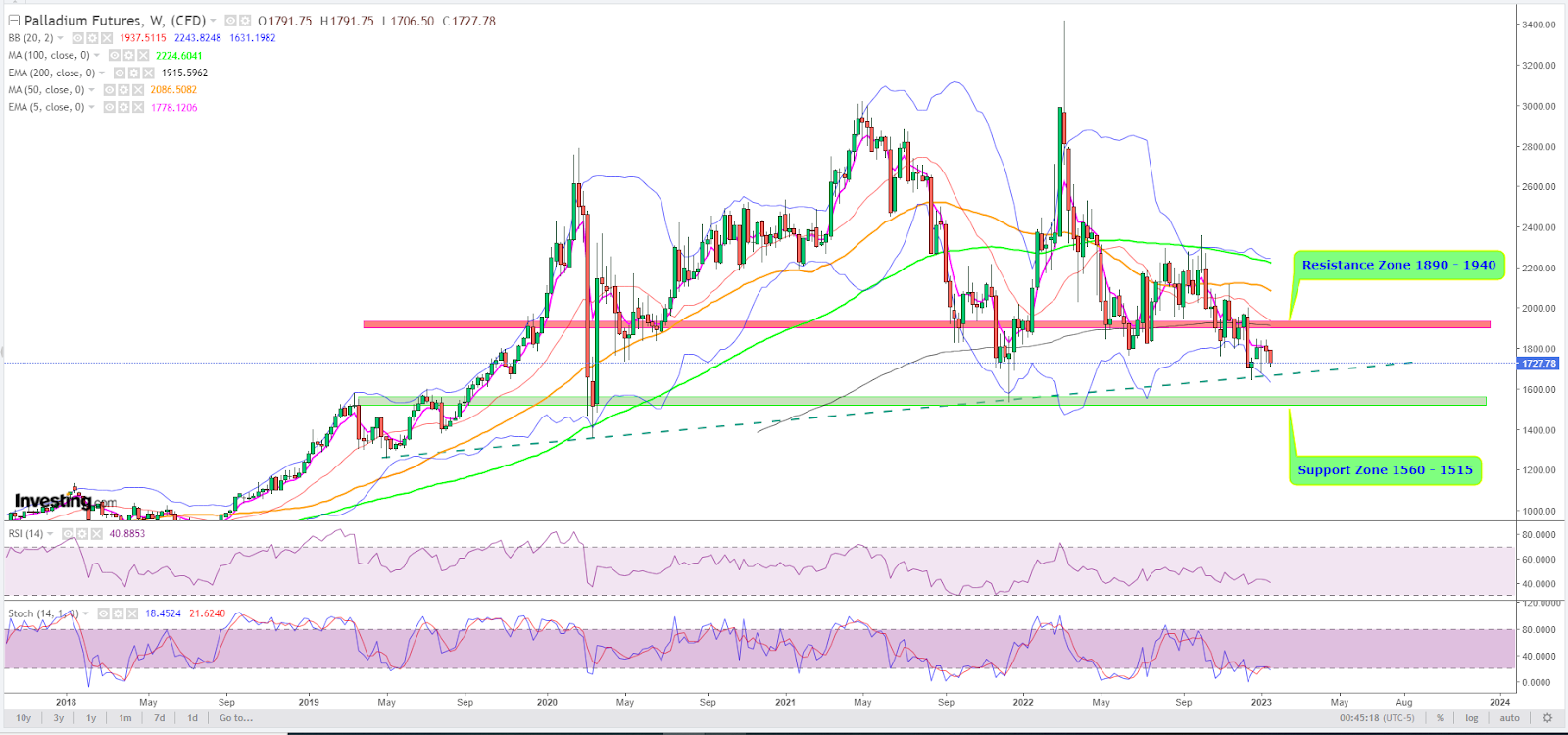Platinum to Stay in Driver’s Seat for 2023, Palladium in Rear-View
2023.01.18 11:20
[ad_1]
- Platinum rally projected to extend as palladium remains in bear-mode
- Demand aided by huge discount on palladium and easier availability
- Both technicals and fundamentals indicate trend is likely to accelerate further in 2023
It’s been branded as the year of specialty metals. Yet, could again steal the race from as its hugely discounted price and easier availability increasingly make it the autocatalyst metal of choice.
Traditionally, gasoline-run cars used palladium as an emissions purifier, while diesel-powered engines relied on platinum-laden catalytic converters. As recently as two years ago, that was the industry standard, with some experts calling platinum a poor substitute for palladium.
But the low price of platinum has since won over naysayers, especially after palladium reached an all-time high above $3,440 in March 2022 versus its so-called sister metal that was trading then at under $1,240 — or about two-thirds cheaper.
 Charts by SKCharting.com, with data powered by Investing.com
Charts by SKCharting.com, with data powered by Investing.com
The use of platinum as a substitute for more costly palladium is likely to accelerate amid concerns about supply from top palladium producer Russia and a drive among carmakers to cut costs, Anglo American Platinum, or Amplats, said. Up to a million ounces of palladium could be switched with platinum over the next five years, Amplats finance director Craig Miller told investors during a conference call in July 2022.
S&P Global said in a closing analysis for last year:
“Platinum was the best-performing precious metal price over the course of 2022, rising 12.0%, compared with a 1.7% fall for palladium and 4.8% and 1.3% rises for silver and gold, respectively.
With Russia normally a major supplier of platinum group metals, or PGMs, supply risks remain, as its invasion of Ukraine has prompted consumers in sanctions-imposing countries to divert supply chains away to other sources.”
The World Platinum Investment Council forecasts a deficit of 303 koz, or kilo ounces, in 2023 as global platinum demand is expected to increase by 19% (to 7,770 koz) while supply increases by just 2% (to 7,466 koz).
The council adds:
“Supply constraints, combined with increased bar and coin demand, have seen the market surplus forecast for 2022 revised downwards by 17% (-170 koz) to 804 koz. The profound swing in market balances between the 2022 surplus and the 2023 deficit is forecast to be more than 1.1 million ounces.”
It added that disruption was likely to remain a feature for platinum in 2023, with the forecast up a modest 2% (+89 koz) year-on-year to 5,726 koz.
The council projected that a combination of higher passenger vehicle production, tighter emissions legislation for heavy-duty vehicles, or HDVs, in China and India, as well as growing substitution of platinum for palladium, will likely lead to a 12% (+329 koz) increase in platinum demand this year, to 2,964 koz.
Platinum substitution for palladium is estimated to have reached 340 koz in 2022 and just over 500 koz next year – more than double the figure in 2021 (240 koz).
Automotive demand in 2023 is expected to have increased at a similar rate to 2022, up 11% (+324 koz) to 3,288 koz. Jewelry demand was forecast to remain unchanged year-on-year at 1,953 koz, while industrial demand is projected to have declined 14% (-341 koz).
But 2023 “is forecast to be the second strongest year for industrial demand on record, climbing 10% to 2,316 koz”, with a notable increase in demand from the glass industry, the council added.
Heraeus Precious Metals in Hanau, Germany, however, said it expected headwinds to the recovering autocatalyst demand in the United States. It adds:
“North American palladium autocatalyst demand is estimated to have grown moderately in 2022 to 1.5 moz, and it has the potential to grow again in 2023 if regional sales recover.”
Heraeus said a combination of higher average vehicle prices and rising interest rates, which nearly doubled over the course of last year, drove up the average monthly finance payment on a new vehicle in the United States in 2022.
Despite this, December did see the highest level of light-vehicle sales in 2022 at 1.3 million units. This is still well below the COVID-19 pandemic-induced microchip shortage levels, suggesting that vehicle inventories may finally recover.
On the price front, according to Bank of America, platinum could rise to $1,322/oz in 2023 from $977 last year. It forecast palladium to trade at $1,865/oz, down from $2,126.
ANZ Research, meanwhile, projected platinum to rise to $1,220/oz in 2023 and $1,300 in 2024 from $1,035 in December 2022. Palladium is expected to average $2,150 by December 2023, rising from $1,927 in December 2022 before dropping to $1,600 by December 2024. Analysts at ANZ added:
“We reiterate our preference for platinum, which is likely to benefit from the advance in gold prices and better auto growth prospects. Furthermore, auto manufacturers are substituting palladium with platinum given the structural deficit, on top of palladium’s supply exposure to Russia.”
The platinum-palladium ratio — or the number of palladium ounces required to buy an ounce of platinum — stands at 0.6 now.

Historically, platinum reached an all-time high of $2,290 in March 2008. Palladium then traded at just around $595, putting the platinum-palladium ratio at 3.8.
Palladium, meanwhile, reached a record high above $3,440 in March 2022 versus a relative platinum value of just under $1,240. The platinum-palladium ratio then was 0.37.
Technical charts, however, tell a different story at least in the near term for platinum futures, which are down 3% since the start of 2023 to settle Tuesday’s trade at just under $1,047.
Sunil Kumar Dixit, chief technical strategist at SKCharting.com, said platinum bears were emboldened by a second weekly bearish streak in a row and taking aim at the 100-weekly Simple Moving Average of $1,017 as the metal remains under the 5-week Exponential Moving Average of $1,055. Adds Dixit:
“Any positivity for platinum requires a weekly sustainability above $1,090, to resume an uptrend aiming at $1,190.”
On the palladium front, bearish pressure in three of the past four months brought futures from an August close of just under $2,180 to around $1,745 now. “Bearish pressure is likely to cause a breach of the ascending trend line at $1,630 and a much lower test at $1,560-$1,515 over the mid term,” said Dixit.
On the flip side, if palladium’s support zones trigger demand, a rebound towards the resistance zone at the 200-week Simple Moving Average of $1,900 could emerge, followed by the weekly Middle Bollinger Band of $1,937 over time.
Disclaimer: Barani Krishnan uses a range of views outside his own to bring diversity to his analysis of any market. For neutrality, he sometimes presents contrarian views and market variables. He does not hold a position in the commodities and securities he writes about.
[ad_2]







